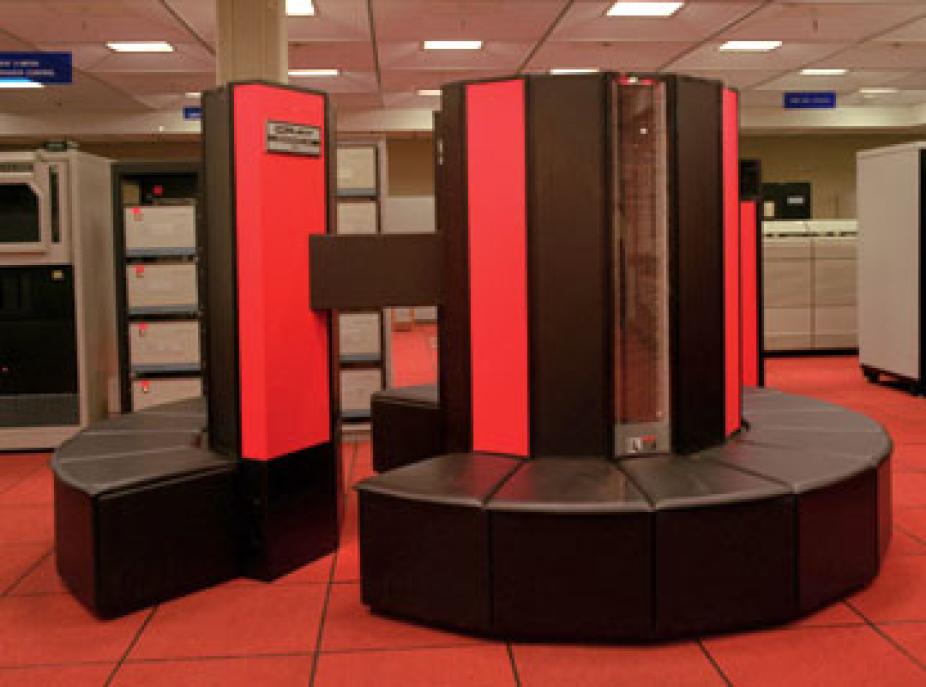CRI Cray X-MP

Cray Research, Inc.
In use: October 1, 1986 - September 30, 1990
Production use
Peak teraflops: 0.00
Processors: 4.00
Clock Speed: 0.12GHz
Memory (terabytes): 0.00TB
Predecessor: CRI Cray-1A S/N 14
Paired with: CRI Cray-1A S/N 3
Successor: CRI Cray Y-MP8
The Cray X-MP/48 was delivered to NCAR in October 1986 and replaced the center’s second Cray-1A. The cost of the X-MP and four-processor I/O subsystem (IOS) was $14.6 million, plus $3.5 million for the 128-megaword (1 gigabyte) solid-state disk (SSD) and $2 million for 16 DD49 disks, each of which had a capacity of 1.2 gigabytes and a transfer rate of 10 megabytes per second.
The power and cooling infrastructure for the underground computing room at the NCAR Mesa Laboratory was expanded to provide the necessary physical facilities for the new computer. The electrical power and grounding systems were replaced, and the cooling system piping – which provided a backup chilled-water source in the event of a failure – was redesigned.
The X-MP/48 featured a new multiprocessor architecture, housing four processors in one cabinet. This opened the door to parallel execution of models, allowing the models to be partitioned into a number of asynchronously executable parts. This mode of use, called multitasking, was the harbinger of modern-day parallel computing. Multitasking was not used extensively at first, but NCAR scientists soon adapted their models to use multiple processors simultaneously, the first being NCAR's Community Climate Model (CCM) in early 1987. That first parallel version of CCM allowed simulations to be done 3.7 times faster on the full X-MP than was possible on a single processor.
Each X-MP processor could execute two instructions in 8.5 nanoseconds, and the system as a whole had a peak computation rate of 941 million floating-point operations per second (megaflops). NCAR's X-MP had a main memory of eight million 64-bit words (64 megabytes). The processors were significantly faster than those of the Cray-1A and could communicate with each other extremely efficiently.
With the installation of the Cray X-MP, computing performance at NCAR had improved about 430 times since the first NCAR computer – the CDC 3600 – was installed in 1963. The cost of a new supercomputer had increased by a factor of about six.
The X-MP/48 increased the computing capability available to NCAR users approximately threefold. Each processor delivered about 500 CPU hours of computer time each month to users. While the system was capable of a peak computation rate of 941 megaflops, the average sustained rate on NCAR's workload was 225 megaflops, approximately 25% of peak. The vector capabilities of the Cray processors, combined with a memory subsystem that could stream data to and from the processors at processor-clock speeds, allowed NCAR applications to achieve such a high percentage of the system's peak processing rate.
The Cray IOS, which had been introduced on larger models of the Cray-1S systems, was an integral part of the X-MP. The IOS accumulated input data for the central processor and distributed output data, which freed the X-MP's CPUs from time-consuming peripheral activities and provided connectivity with a variety of equipment from other vendors, including CDC, IBM, VAX, and Sun.
As with NCAR's two Cray-1A systems, the X-MP ran the Cray Operating System. Other X-MPs ran either the Cray Time-Sharing System (which was jointly developed by the Los Alamos and Lawrence Livermore National Laboratories) or UNICOS (developed by Cray Research, Inc., based on AT&T's UNIX System V technology. The X-MP was the last supercomputer at NCAR to run an operating system that was not based in some manner on UNIX, from which today's ubiquitous Linux operating system was derived.
While NCAR's Cray X-MP/48 was decommissioned on September 30, 1990, four months after the Cray Y-MP8/864 arrived, its SSD and 20 gigabytes of disk were connected to the Cray Y-MP.